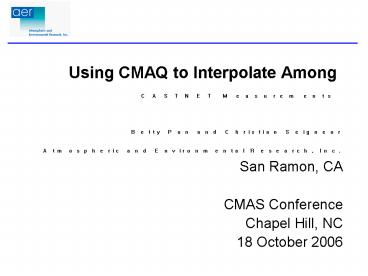Using CMAQ to Interpolate Among CASTNET Measurements PowerPoint PPT Presentation
1 / 13
Title: Using CMAQ to Interpolate Among CASTNET Measurements
1
Using CMAQ to Interpolate Among CASTNET
Measurements
- Betty Pun and Christian Seigneur
- Atmospheric and Environmental Research, Inc.
- San Ramon, CA
- CMAS Conference
- Chapel Hill, NC
- 18 October 2006
2
MOTIVATION
- Number of monitors limited for any network (e.g.,
CASTNET) - Traditional interpolation approaches (e.g.,
inverse distance weighting method) have
limitations - In areas without monitor coverage
- impossible to provide estimates
- In areas with limited coverage
- undue influence of a single monitor
- missing or crude gradient information
- source http//www.epa.gov/castnet
3
GOAL
- Chemical transport models (e.g., CMAQ) provide
concentration fields on a uniform grid,
accounting for - topography
- emission density
- land use
- meteorology
- current science regarding transformations
- An interpolation scheme that uses CTM to provide
gradient information between point measurements
4
MATCHING SPECIES
CASTNET quantities CMAQ variables Notes
PM sulfate SO4 ASO4IASO4J 1
sulfur dioxide totalSO2 SO2
total nitrate totalNO3 ANO3IANO3JHNO3 1
PM ammonium NH4 ANH4IANH4J 1,2
PM sulfate dry deposition SO4_FLUX ASO4IddASO4Jdd 1,3
sulfur dioxide dry deposition SO2_FLUX SO2dd 3
total nitrate dry deposition NO3_FLUXHNO3_FLUX ANO3IddANO3JddHNO3dd 1,3
PM ammonium dry deposition NH4_FLUX ANH4IddANH4Jdd 1,2,3
1. particle size range may not correspond exactly
because open-face filters do not have size cut
off but model simulates Aitken and accumulation
modes. 2. may be subject to volatilization. 3.
deposition velocity estimates may differ between
CASTNET and CMAQ.
5
INTERPOLATION METHODGuiding Principles
- At locations with measurements
- interpolated concentrations equal measured
concentrations - At locations with no nearby concentrations
- interpolated concentrations equal modeled
concentrations - At locations near one or more monitors
- interpolated concentrations governed by
magnitudes of concentration(s) at nearby
monitor(s) AND gradients in the modeled
concentration field
6
INTERPOLATION METHODFormulation
- Error at center of each grid cell
- Weight of each site error term
- if ricell,jcell,ksite lt rinfluence
- if ricell,jcell,ksite gt rinfluence
- Error at each site (ksite)
- Interpolated concentration at center of each grid
cell (icell, jcell)
7
INTERPOLATION METHODParameter Radius of
Influence
- Ensure all locations within the contiguous U.S.
is influenced by at least one CASTNET site - rinfluence 720 km
8
INTERPOLATION METHODParameter Number of Virtual
Sites
- Eksite 0
- ricell,jcell,ksite rinfluence
- temper the influence of single monitors where
sites are sparse - avoid abrupt changes in interpolated
concentrations when transitioning from monitor to
model values
nvirtual 0
nvirtual 4
9
RESULTSAnnual Concentrations (mg/m3)
- Total Nitrate
- model added gradients from lower Midwest
- urban areas highlighted
- Sulfate
- model added gradients away from OH River Valley
10
RESULTSDry Deposition Fluxes (kg/ha)
- Total Nitrate
- model adds strong gradients and spatial
variability
- Sulfate
- dominated by measurements
- predictions biased low
11
EVALUATION
- PM Sulfate 2001
- Interpolated CASTNET field versus IMPROVE
measurements
- Number of IMPROVE sites 93
- Mean observation 1.63 mg/m3
- Mean prediction 1.67 mg/m3
- Mean bias 0.03 mg/m3
- Mean normalized bias 7
- Mean error 0.18 mg/m3
- Mean normalized error 14
- r2 0.96
- Comparable performance for eastern vs. western
U.S. - Comparable performance for different seasons
12
CONCLUSIONS
- Models can be used to interpolate measurements
effectively - realistic gradients
- add information where there are sharp gradients
not captured by monitors - For sulfate, evaluation shows interpolation to be
reliable for annual and seasonal concentrations
for non-urban areas - Interpolation subject to potential weaknesses in
models
13
ACKNOWLEDGMENTS
- Funding provided by EPA
- Contract 68-W-03-033
- Work assignments 2-15, 3-15
- Project Manager Bryan J. Bloomer

